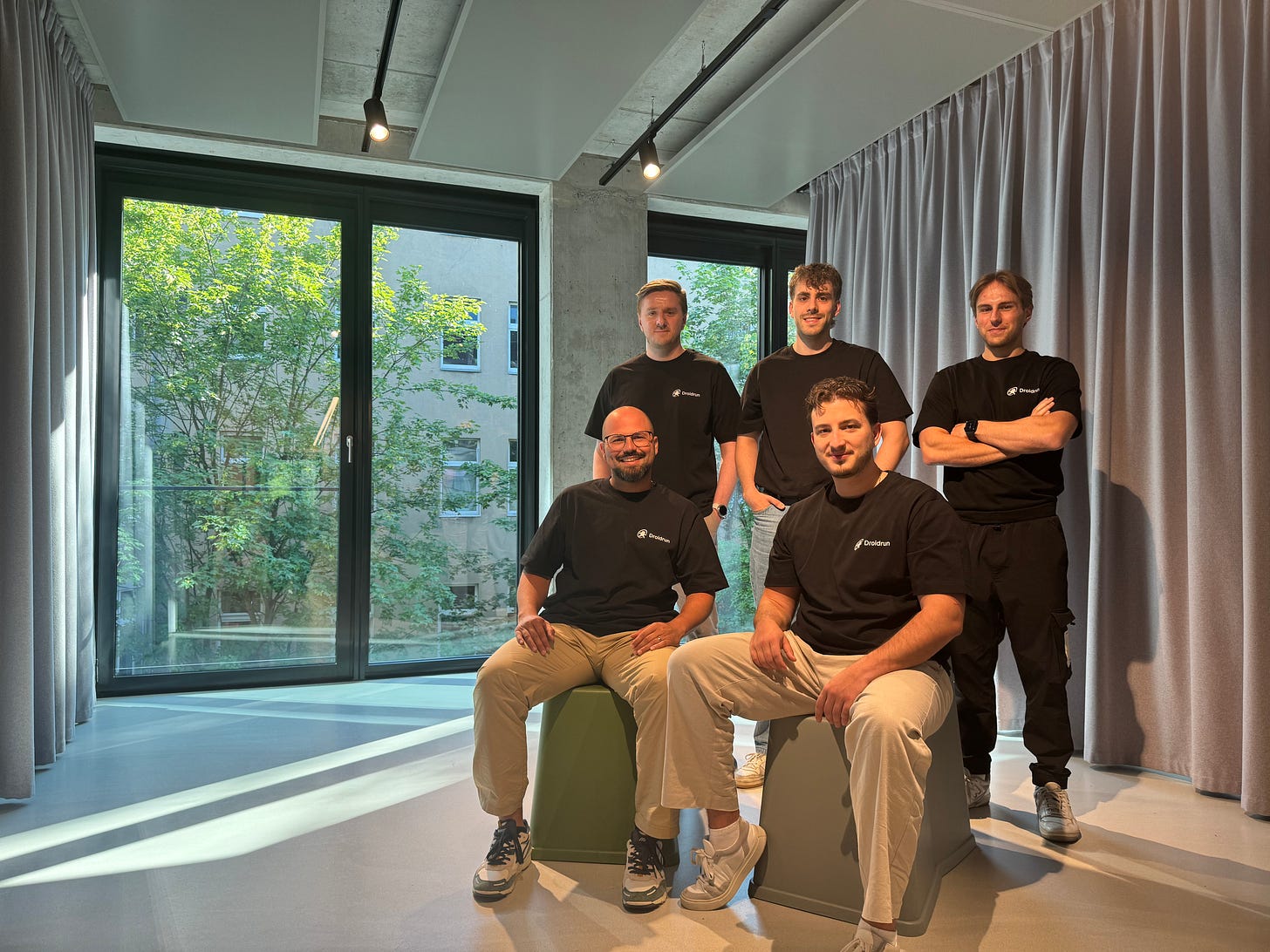Agents are automating desktop and web workflows, but mobile is the real frontier
Why we invested in Droidrun to scale mobile-native AI agent infrascture
The news is out: Merantix Capital has led Droidrun’s €2.1M pre-seed round, with participation from SixtyDegree Capital, Peter Sarlin, Philipp Langnickel, Mandeep Singh, Felix Jahn and a group of strategic angels from the open-source and AI agent ecosystem.
Check out the great coverage in Handelsblatt, Tech EU, and Tech Funding News.
Here’s why we’re really excited. When you look at the AI agent landscape, things are moving quickly with desktop and web workflows. But mobile, the dominant user interface, is still untapped. We’re soon going to be looking at a world where you don’t need to switch between six apps to check flights, book a hotel, file your expenses, and update your calendar and colleagues. You’ll tell your agent to “book my trip to Berlin next week for the client meeting.”
That’s what Droidrun is building, and the company has already gone viral for its open-source efforts, with 900+ developers signing up for the framework in 24 hours, collecting 3,300+ GitHub stars and becoming the fastest-growing mobile agent project.
Droidrun does that by taking a different approach. “We give the AI the exact structure of what's on screen,” co-founder and CEO Christian Ninstel explained to me recently. “It's like creating an API for every mobile app that's ever been built.”
We’ve been wowed by Droidrun’s speedy traction and the execution abilities of the team. I recently sat down with Christian to hear about Droidrun’s growth and where things go from here. Below is our edited conversation.

Adrian: You built Droidrun after hitting a wall with existing mobile automation. What exactly was broken, and how did you solve it differently?
Christian: We needed AI agents to retrieve product insights from viral TikTok videos for our previous startup. Sounds simple, right? But every existing mobile automation solution failed spectacularly on real apps. They all break when apps update their UI or when you need to handle dynamic content.
The problem is that they try to "see" screens like humans do, which is slow and unreliable. We took the opposite approach: converting mobile interfaces into structured text that LLMs can process directly. Instead of trying to find a button by its visual appearance, we give the AI the exact structure of what's on screen. It's like creating an API for every mobile app that's ever been built.
900+ developers signed up in 24 hours after launch. That's incredible traction for a dev tool. What drove that viral moment?
We launched with a bold claim: "AI can now use your phone." But more importantly, we had a working demo that actually delivered on that promise. Developers had been frustrated by the same mobile automation problems we faced.
The virality came from community channels like Reddit, X, and open-source visibility. We hit 1,000 GitHub stars in under 48 hours because developers could immediately see the value and start testing it.
To maintain growth, we're doubling down on community, developer experience, shipping cloud runtimes, and integrating with major agent frameworks like LangChain, CrewAI, and AutoGen.
Can you walk me through some concrete use cases where Droidrun is already creating value?
We're not building apps, we're building the infrastructure layer that powers them. Think of us as the execution runtime that other companies build on top of.
QA Infrastructure: For example, QA Startups can integrate Droidrun to offer "AI-powered mobile testing" to their customers. Instead of manually writing test scripts, QA teams just describe what they want to test in natural language, and our agents execute across real devices. We're seeing testing companies add mobile AI capabilities to their platforms in weeks, not years. We also discovered that our cloud infrastructure is what a lot of companies can use to scale up and decrease costs.
RPA Platform Extensions: Major automation platforms could integrate Droidrun to extend their desktop workflows to mobile. Imagine a business process that starts in Salesforce, moves to email, then needs to update a mobile-only app - that final step was impossible before. Now RPA providers can offer end-to-end automation that includes mobile.
What's interesting is that we're often faster and more reliable than desktop automation. Desktop RPA deals with complex browser environments, bot detection systems, and constant UI changes. Mobile apps are more predictable; they have consistent UI patterns and fewer anti-automation measures. Our structured text approach bypasses the visual complexity that slows down desktop automation.
Agent Framework Infrastructure: LangChain, CrewAI, and AutoGen are integrating Droidrun so their agents can execute mobile actions. Developers building AI assistants can now say "and also handle mobile workflows" without building mobile automation from scratch.
Enterprise Automation APIs: Companies in fintech and logistics could use our APIs to automate mobile-only business processes. One financial services company built an automated compliance system that verifies transactions across 12 different banking apps - something that was previously 100% manual.
Developer Tool Platforms: Testing and monitoring platforms are white-labeling our technology to offer "mobile AI agents" as a feature. They focus on their core product, and we handle the complex mobile execution layer.
The pattern is clear: everyone wants mobile AI capabilities, but building reliable mobile automation is incredibly hard. We're the infrastructure layer that lets other companies ship mobile AI features without spending years solving the core execution problem.
Mobile is notoriously locked down, especially iOS. How are you handling the technical challenges of cross-platform support?
We already support iOS in private beta, but you're right - iOS is more restrictive. We had to work around stricter sandboxing and app store limitations.
Our approach is hybrid: Android for open experimentation and rapid iteration, iOS for enterprise integrations where we can work within corporate device management systems.
The key insight is that enterprises want this capability badly enough to work within platform constraints. Long-term, we're building toward a unified cross-platform runtime that's open, fast, and production-ready.
Where do you see the biggest opportunities for Droidrun in the next 2-3 years?
Short-term: High-friction industries where APIs don't exist or fall short - fintech, healthcare, logistics. These sectors run on mobile apps but lack automation infrastructure. Banks need to verify payouts, hospitals need to update patient records, logistics companies need to track shipments - all through mobile apps.
Long-term: We're building toward a world where mobile becomes an agentic operating system. Instead of opening ten apps to book a business trip, you express intent and agents execute across your entire mobile ecosystem.
The market timing is perfect - AI agents are exploding, mobile usage is dominant, but the two haven't connected yet. We're building that bridge.
You've raised €2.2M in a challenging funding environment. How are you planning to use this capital?
Three priorities:
Team expansion. Growing our core engineering team to ship faster.
Cloud infrastructure. Launching managed runtimes for Android and iOS so developers & enterprises can deploy at scale.
Ecosystem growth. Deep integrations with agent frameworks and developer tools, plus early proof-of-concept products.
The key is staying open-source at the core. That's what drove our initial traction, and it's how we'll build the ecosystem. The funding lets us accelerate without compromising on that developer-first approach.



